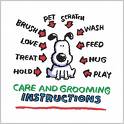We’ve already established that regular grooming is important to your dog’s overall health and well-being. How exactly do you know your dog's coat is healthy? Knowing your dog’s coat type will give you an understanding of what is “normal” and healthy for your dog.
Before we continue, let’s take note here that no amount of grooming will give your dog the healthy skin and coat it deserves. Good nutrition is the number one factor affecting the condition of your dog’s skin and coat. But grooming is beneficial in many ways to your dog’s health. For more details on these benefits, check out my article on grooming on my pet grooming blog.
A dog's hair is made up of an elastic and flexible filament. It is very similar to that of a human's as it grows, gets old, dies and is then replaced with new hair. A dog can be double coated, having both a soft undercoat and a coarser topcoat, or single coated, having only one type of coat or the other. Of course there are many different types of dogs with different types of hair coats.
Most dogs shed their undercoat each spring and regrow it again as colder weather comes in, although some breeds shed their coat twice a year. In many climates, the topcoat and undercoat might shed continuously in greater and smaller quantities all year. Normally dogs that have long straight hair shed two times a year, while dogs that have shorter hair can shed all throughout the year. Dogs that have stiff, bristled or curly hair shed less, but their hair continues growing all year long.
Dog coats can be broken down into several categories. I have seen them classified differently by different sources, but for our purposes we will put them into five groups: smooth, wiry, short, medium and long.
A smooth coat is short, sleek and shiny. Dogs with a smooth coat look almost like they are covered with a skin rather than fur. Here are a few well known smooth-coated breeds: Beagle, Dalmatian, Great Dane and Weimeraner.
There are several breeds that sport a wiry coat that is rougher and, well, wiry. A few of these breeds are the Airedale Terrier, German Wirehaired Pointer and the Scottish Terrier.
A short hair coat has a length of 1 to 4 centimeters. This type of hair coat is usually hard to the touch and stiff. One common breed with this type of hair coat is the Chinese Shar-Pei.
A medium coat is generally longer than one inch, but is still noticeably shorter than long haired breeds. The following are some common medium-coated breeds: Australian Shepherd, Border Collie, Golden Retriever and Blue Heeler.
Long-coated breeds are divided into three sub-categories: long parted coat, long-coated small dog, and long-coated large dog. Each type has slightly different grooming requirements. Long parted coat breeds are few in number. Here are a few: Afghan Hound, Lhasa Apso and Yorkshire Terrier. The following are some popular long-coated small dogs: Havanese, Chinese Crested, Pekingese and Pomeranian. Finally, here are some examples of popular long-coated large dogs: Chow Chow, Irish Setter, Newfoundland and Old English Sheepdog.
Once you’ve pinpointed your dog’s coat type, do a little research on what a healthy coat looks and feels like for that type. Using your sense of touch, sight and smell you can begin to recognize the characteristics of a "normal" or "healthy" skin and coat.
A coat that feels healthy will have a soft texture to the hairs, and even in wiry coats, the coat should be pliable and smooth. An unhealthy coat will be made up of dry, coarse, brittle hairs, some broken off, some very fine. The coat may be sparse and thinning or short and underdeveloped.
Skin that looks healthy will have a clean look to it and be free of scales, scabs and crusts. A healthy coat will appear full, almost lustrous and have a soft look to it. Unhealthy skin will appear thin, dry and scaly or greasy. The coat will look dull, coarse or even dusty. It will have no "shine" to it and will have a harsh appearance.
As for the sense of smell, a healthy skin and coat won't have any smell to it. Even when its dirty, it will simply smell like whatever is making it dirty. An unhealthy skin and coat will have a strong, rancid, oily odor. This odor is caused by superficial skin bacteria and their waste products breaking down the oils on the skin.
Well, that about sums up the subject of dog hair coats by type and condition. Hopefully you have a pretty good idea of what type of coat your dog has and how it should look, feel when healthy. You can find more Pet Grooming Tips by visiting my site at http://www.pet-grooming-boarding.info
Subscribe to:
Post Comments (Atom)



No comments:
Post a Comment